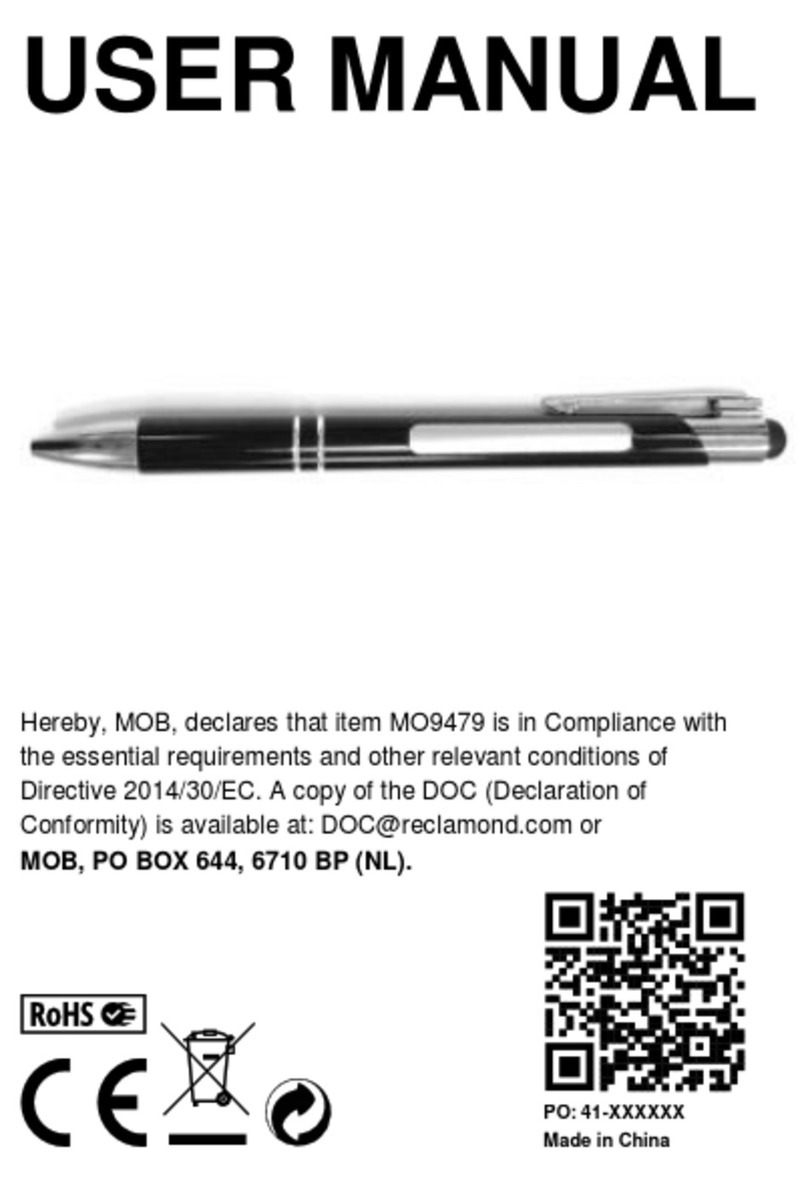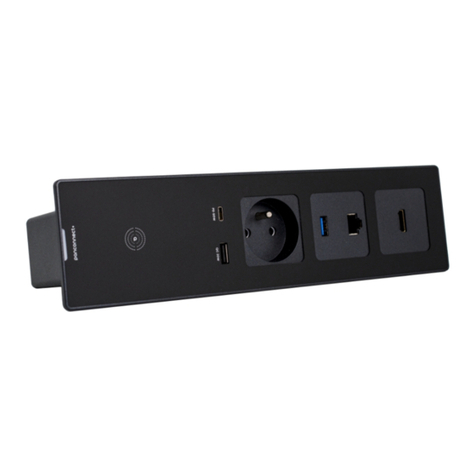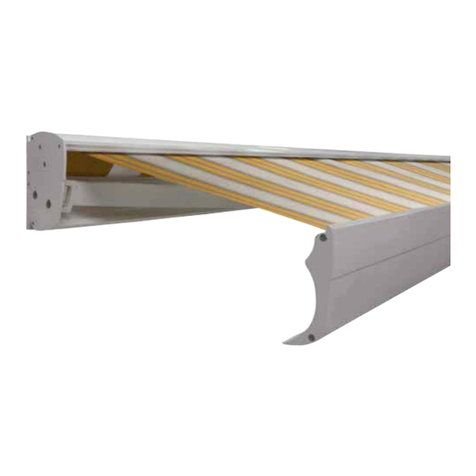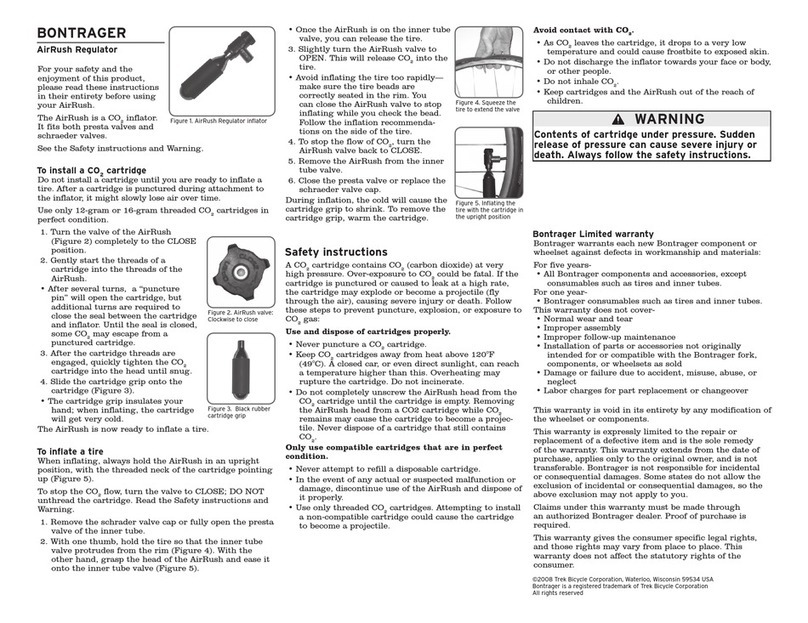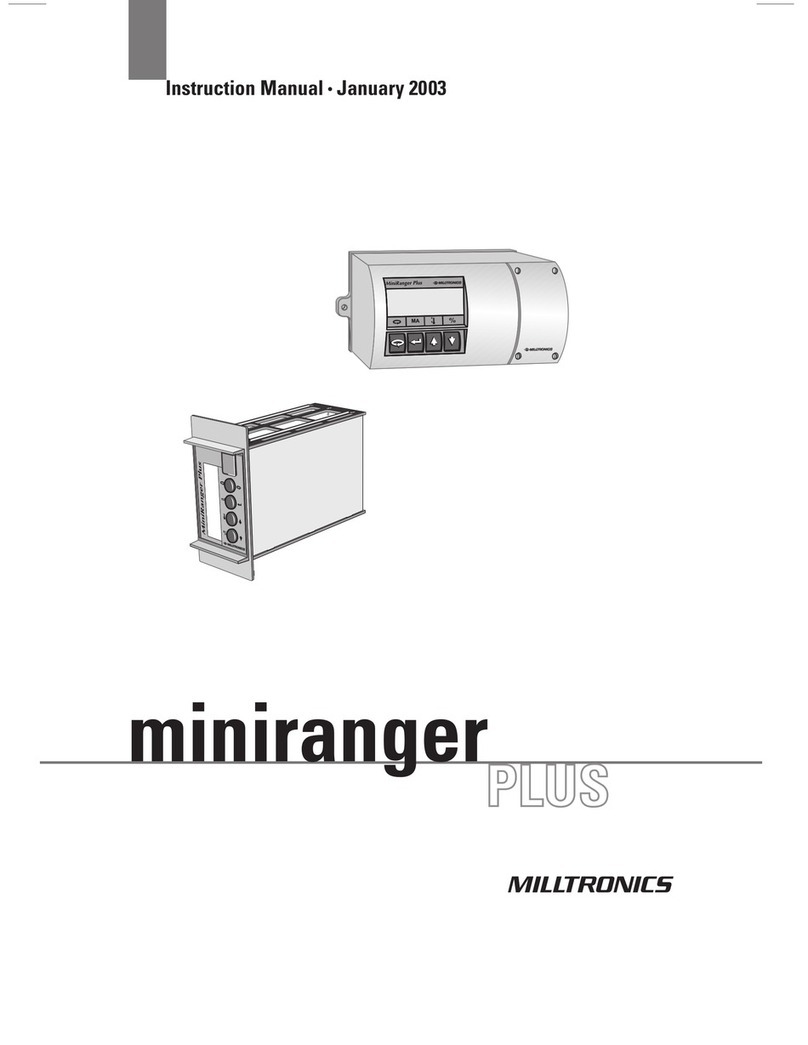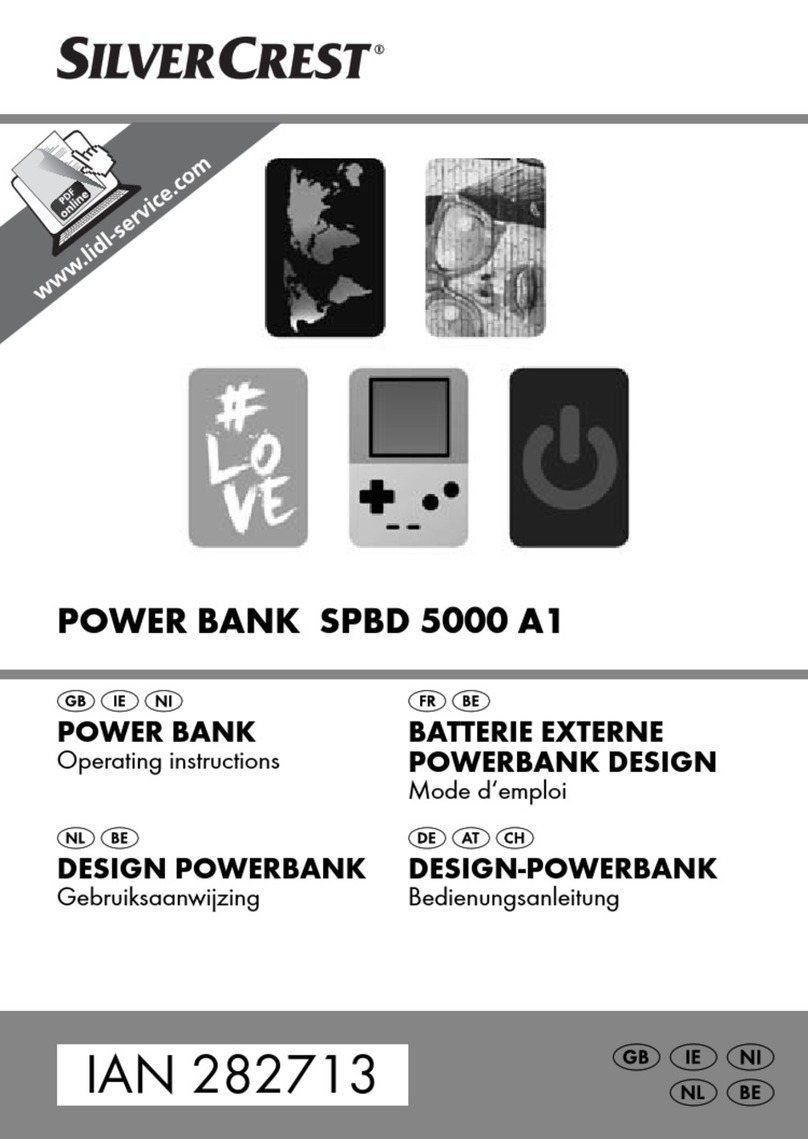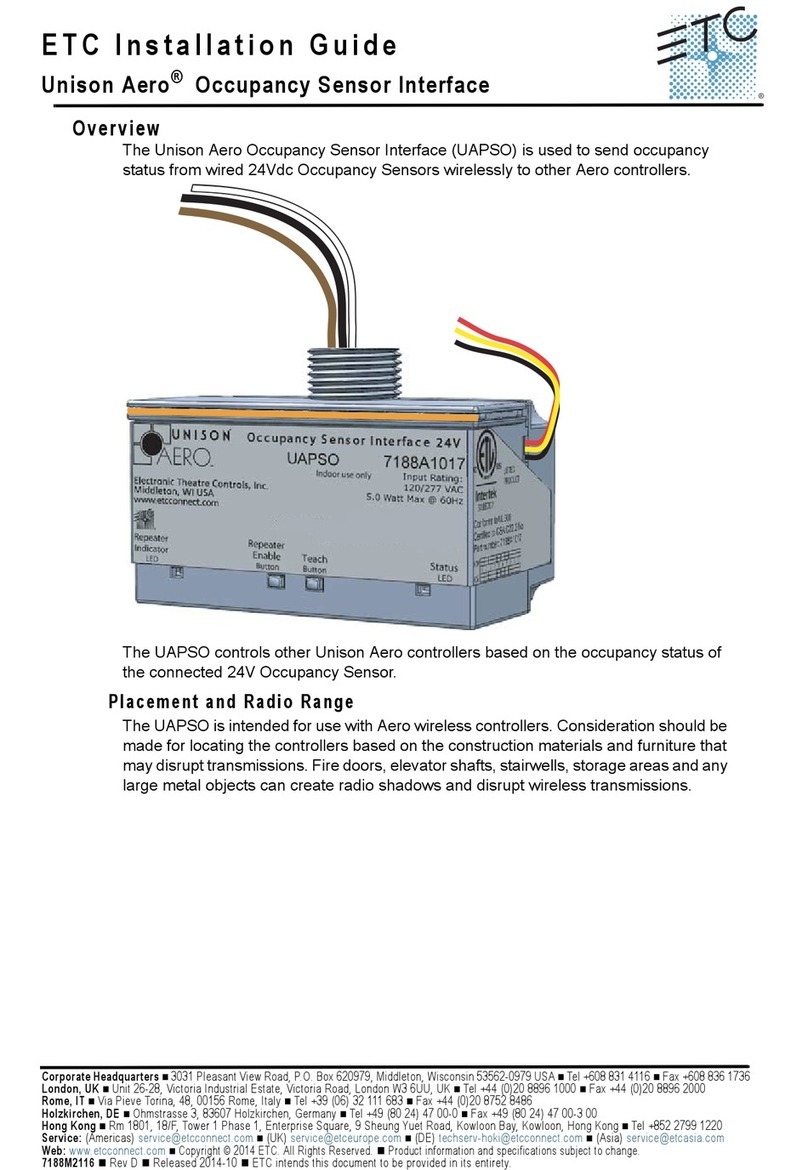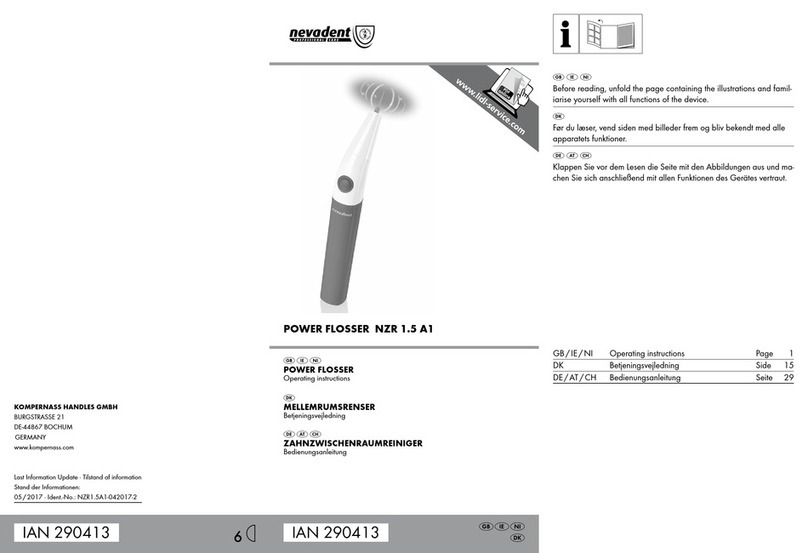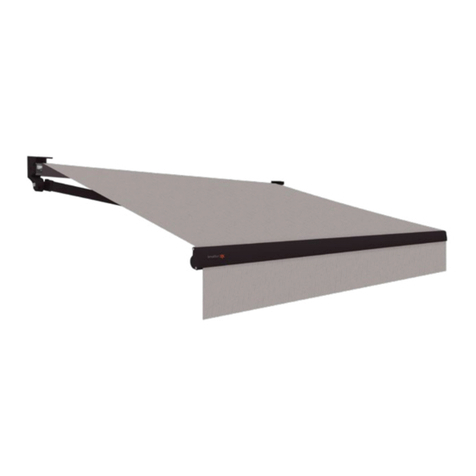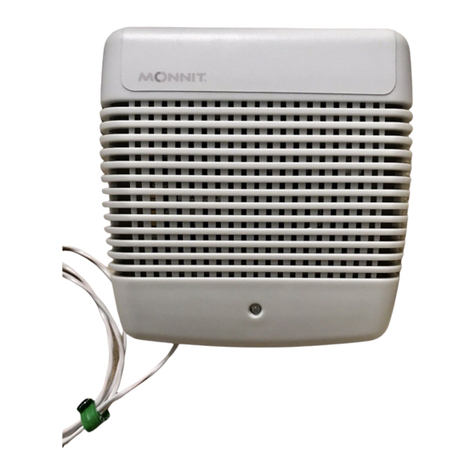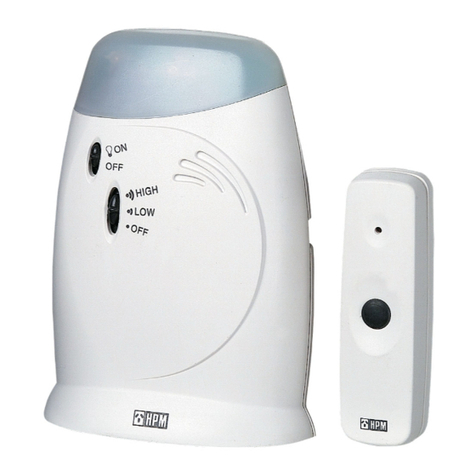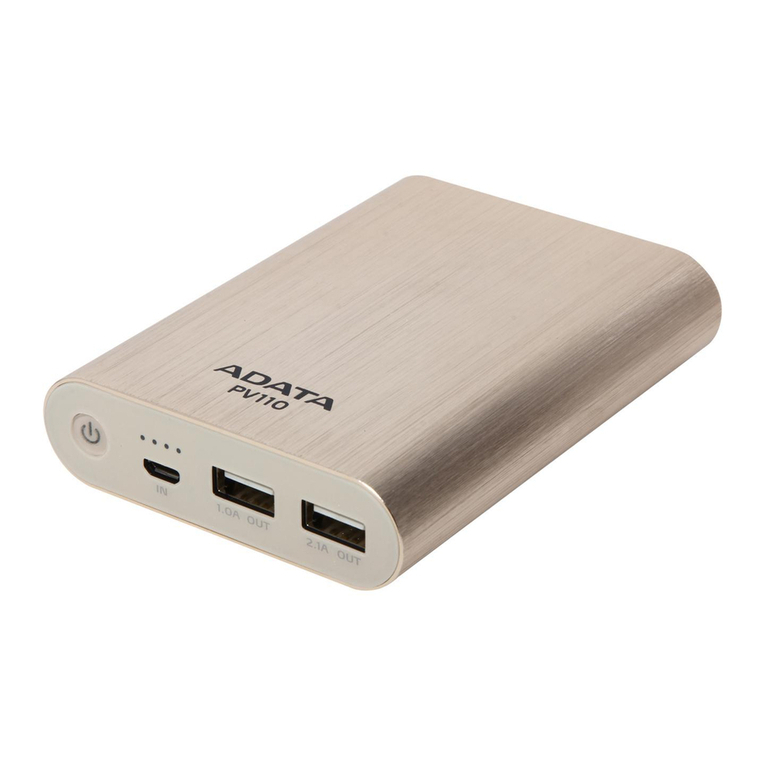Robur AD Series User manual

For natural, simple and aordable cooling of medium and
large buildings
AD evaporative coolers
Installation, use and maintenance manual

This Installation, use and maintenance manual has been drawn up and printed by Robur S.p.A.; whole or partial reproduction of this
Installation, use and maintenance manual is prohibited.
The original is led at Robur S.p.A.
Any use of this Installation, use and maintenance manual other than for personal consultation must be previously authorised by Robur S.p.A.
The rights of those who have legitimately led the registered trademarks contained within this publication are not aected.
With the aim of continuously improving the quality of its products, Robur S.p.A. reserves the right to modify the data and contents of this
Installation, use and maintenance manual without prior notice.
Revision: B
Code: D-LBR754EN
DISPOSAL
The appliance and all its accessories must be disposed of separately in accordance with the regulations in force.
Use of the WEEE symbol (Waste Electrical and Electronic Equipment) indicates that this product cannot be disposed of as household waste.
Proper disposal of this product helps to prevent potential negative consequences for the environment and human health.

Installation, use and maintenance manual – AD 3
INDEX OF CONTENTS
I Introduction.............................................................................
p.4
I.1 Recipients ..........................................................................
p.4
I.2 Control device..................................................................
p.4
II Symbols and denitions...............................................
p.4
II.1 Key to symbols.................................................................
p.4
II.2 Signage applied on the appliance............................
p.4
II.3 Terms and denitions....................................................
p.4
III Warnings......................................................................................
p.4
III.1 General and safety warnings......................................
p.4
III.2 Conformity ........................................................................
p.5
III.3 Exclusions of liability and warranty..........................
p.5
1 Features and technical data......................................
p.6
1.1 Features..............................................................................
p.6
1.2 Dimensions .......................................................................
p.7
1.3 Electrical wiring diagram .............................................
p.8
1.4 Controls ..............................................................................
p.9
1.5 Technical characteristics.............................................
p.10
1.6 System operation..........................................................
p.10
2 Transport and positioning........................................
p.11
2.1 Warnings ..........................................................................
p.11
2.2 Handling...........................................................................
p.11
2.3 Storage..............................................................................
p.11
2.4 Appliance positioning.................................................
p.11
3 Heating engineer...............................................................
p.15
3.1 Warnings ..........................................................................
p.15
3.2 Hydraulic connections ................................................
p.15
4 Electrical installer..............................................................
p.16
4.1 Warnings ..........................................................................
p.16
4.2 Electrical systems..........................................................
p.16
4.3 Electrical power supply...............................................
p.16
4.4 Control system...............................................................
p.16
5 First start-up ..........................................................................
p.17
5.1 Preliminary checks........................................................
p.17
5.2 Suggestions for the rst start-up ............................
p.17
6 Normal operation..............................................................
p.18
6.1 Warnings ..........................................................................
p.18
6.2 Switch on and o..........................................................
p.18
7 Maintenance..........................................................................
p.18
7.1 Warnings ..........................................................................
p.18
7.2 End of season maintenance......................................
p.18
7.3 Pre-season maintenance............................................
p.18

Introduction
4
I
I INTRODUCTION
Manual
This Manual is an integral part of the AD unit and must
be handed to the end user together with the appliance.
I.1 RECIPIENTS
This Manual is intended for:
▶
End user, for appropriate and safe use of the appliance.
▶
Qualied installer, for correct appliance installation.
▶
Planner, for specic information on the appliance.
I.2 CONTROL DEVICE
In order to work, the AD unit requires a control device to be con-
nected by the installer (see Paragraph 1.4
p.9
).
II SYMBOLS AND DEFINITIONS
II.1 KEY TO SYMBOLS
DANGER
WARNING
NOTE
PROCEDURE
REFERENCE (to other document)
II.2 SIGNAGE APPLIED ON THE APPLIANCE
Live electrical parts: warns of danger from live electri-
cal parts.
Mechanical parts: warns of danger due to moving me-
chanical parts.
II.3 TERMS AND DEFINITIONS
Appliance / Unit = equivalent terms, both used to refer to the
evaporative cooler AD.
TAC = Technical Assistance Centre authorised by Robur.
III WARNINGS
III.1 GENERAL AND SAFETY WARNINGS
Installer's qualications
Installation must exclusively be performed by a qualied
rm and by skilled personnel, with specic knowledge
on heating, hydraulic and electrical systems, in compli-
ance with the laws in force in the Country of installation.
Declaration of conformity
Upon completing installation, the installing rm shall
issue to the owner/client the appliance's workmanlike
conformity declaration, according to national/local reg-
ulations in force and the manufacturer's instructions/
provisions.
Misuse
The appliance must only be used for the purposes for
which it has been designed. Any other use is deemed
hazardous. Incorrect use may aect operation, duration
and safety of the appliance. Adhere to the manufactur-
er's instructions.
Use of the appliance by children
The device can be used by children over 8 years old,
and by people with reduced physical, sensory or mental
capabilities, or lack of experience or knowledge, only if
they are under surveillance or after they have received
instructions regarding safe use of the appliance and un-
derstanding the dangers inherent in it. Children should
not play with the appliance. Cleaning and maintenance
that must be performed by the user must not be per-
formed by unsupervised children.
Hazardous situations
Do not start the appliance in hazardous conditions, such
as: problems with the electrical system, disassembled or
damaged parts of the appliance, malfunctioning, disa-
bling or bypassing of control and safety devices.
In case of danger, request intervention by qualied per-
sonnel.
In case of danger, switch o the electrical power supply
only if this can be done in total safety.
Do not entrust children, persons with physical, sensory
or mental disabilities or persons with poor knowledge
and experience with use of the appliance.

Warnings
Installation, use and maintenance manual – AD 5
III
Moving parts
The appliance contains moving parts.
Do not remove guards during operation, and in any case
prior to disconnecting the power supply.
Electrocution hazard
Disconnect the electrical power supply before any oper-
ation on appliance components.
For electrical connections exclusively use compliant
components and according to the specications provid-
ed by the manufacturer.
Ensure the appliance cannot be accidentally switched
back on.
Earthing
Electrical safety depends on eective earthing system,
correctly connected to the appliance and installed ac-
cording to the regulations in force.
Aggressive substances in the air
The air of the installation site must be free of any aggres-
sive substances or impurities that could contaminate the
evaporative packs of the appliance.
Switching the appliance o
Except in the event of danger, do not disconnect the
power supply to switch o the appliance, but always and
exclusively act through the provided control device.
In the event of failure
Operations on internal components and repairs may
exclusively be carried out by a TAC, using only original
parts.
In the event of failure of the appliance and/or breakage
of any component, do not attempt to repair and/or re-
store and immediately contact the TAC.
Appliance positioning
Do not install the machine in closed areas; it must be in-
stalled outside the room to be treated, unless by specic
approval by the manufacturer.
First start-up
Do not operate the unit until the air supply duct has
been installed and connected.
Wastewater
During normal operation of the system in cooling mode,
the evaporation process produces an accumulation of
mineral salts and solid residues in the waste water; this
water is not potable.
Routine maintenance
Proper maintenance assures the eciency and good op-
eration of the appliance over time.
Maintenance must be performed according to the
manufacturer's instructions (see Chapter 7
p. 18
) and
in compliance with current regulations.
Enter into a maintenance contract with an authorised
specialised rm for routine maintenance and for servic-
ing in case of need.
Use only original parts.
Keep the Manual
This Installation, use and maintenance manual must al-
ways accompany the appliance and must be handed to
the new owner or installer in the event of sale or removal.
III.2 CONFORMITY
EU Directives and standards
The AD evaporative coolers comply with the essential require-
ments of the following Directives:
▶
2014/30/EC "Electromagnetic Compatibility Directive" as
amended and added.
▶
2014/35/EC "LowVoltage Directive" as amended and added.
▶
2006/42/EC "Machine Directive" as amended and added.
▶
327/2011/EU "Ecodesign requirements for fans" as amended
and added.
Other applicable provisions and standards
The design, installation, operation and maintenance of the sys-
tems shall be carried out in compliance with current applicable
regulations, depending on the Country and location, and in ac-
cordance with the manufacturer's instructions. In particular, reg-
ulations regarding the following shall be complied with:
▶
Electrical systems and equipment.
▶
Any other applicable law, standard and regulation.
III.3 EXCLUSIONS OF LIABILITY AND
WARRANTY
Any contractual or extra-contractual liability of the man-
ufacturer for any damage caused by incorrect installa-
tion and/or improper use and/or failure to comply with
regulations and with the manufacturer's directions/in-
structions shall be disclaimed.
In particular, the warranty on the appliance may be ren-
dered void by the following conditions:
Incorrect installation.
Misuse.
Failure to comply with the manufacturer's indications on
installation, use and maintenance.
Alteration or modication of the product or any part
thereof.
Extreme operational conditions or however outside of
the operational ranges set forth by the manufacturer.
Damages caused by external agents such as salts, chlo-
rine, sulphur or other chemical substances present in the
air of the installation site and/or in the water supply to
the appliance.
Abnormal actions transmitted to the appliance by the
plant or installation (mechanical stresses, pressure, vi-
brations, thermal expansion, electrical surges...).
Accidental damages or due to force majeure.

Features and technical data
6
1
1 FEATURES AND TECHNICAL DATA
1.1 FEATURES
1.1.1 Available range
The AD evaporative coolers are available in two models, which
dier in the maximum air ow that can be delivered:
▶
AD14 with air ow up to 13000 m³/h
▶
AD20 with air ow up to 20000 m³/h
Three dierent versions are available for each model, two of
which are equipped with an independent basic (ECO) or ad-
vanced (EVO) remote control for each unit, and the third (SC) is
suitable for the centralised management of a system composed
of a maximum of 30 units, to be associated with a centralised
control system, supplied by Robur.
The three versions can be summarized as follows:
▶
AD14/AD20 ECO: equipped with the basic ECO remote con-
trol (Paragraph 1.4.2
p.9
).
▶
AD14/AD20 EVO: equipped with the advanced EVO remote
control (Paragraph 1.4.3
p.9
).
▶
AD14/AD20 SC: without individual remote control, but de-
signed for a centralised control (Paragraph 1.4.4
p.9
).
1.1.2 Operation
To improve the summer microclimate inside an industrial,
commercial or another type of room, it is necessary to ventilate
the room with many fresh and ltered air renewals, possibly
cooled. In the case of large rooms, for example industrial ones,
an air cooling system is often not advisable because, due to the
large volume of air to be cooled and the thermal loads of the
processes to be neutralized, the amount of energy required is
very high and the cooling eect is reduced by the exhaust air
extraction systems and by the frequent opening of the doors to
carry out the activity.
An excellent solution is represented by an evaporative cooling
system that cools the air with a natural principle: the air passes
through special lters wet with water, transfers part of its heat
during the process of evaporation of the water and lowers its
temperature. The absence of refrigeration machines reduces en-
ergy consumption to a minimum and allows large volumes of air
to be treated for the many necessary air renewals.
The AD evaporative cooler can be installed in all environments
where it is necessary to improve the microclimate, where it is
necessary to ventilate the environment with many fresh and l-
tered air renewals, possibly cooled, such as:
▶
production and crafts premises
▶
commercial premises and warehouses
▶
sports premises in general

Features and technical data
Installation, use and maintenance manual – AD 7
1
1.2 DIMENSIONS
Figure1.1AD14 dimensions
A Water inlet 3/8" M
B Water drain 60 mm M
C Electrical panel
B
A
C
600
660
630
600
660
630
B
C
A
D
D
D-D
1150
209
65
320
595
280
555
170
38
1150
1050
117
110
440
80
217112
243
86

Features and technical data
8
1
Figure1.2AD20 dimensions
A Water inlet 3/8" M
B Water drain 60 mm M
C Electrical panel
AB
CB
CA
150
530
825
825
1185
1215
1245
590
660
620
1150
1050
130
165
280
80
530
189
128
592.5 592.5
261.5
195
85170
205
DD
D-D
1650
1.3 ELECTRICAL WIRING DIAGRAM
Figure1.3Electrical wiring diagram
1 Onboard electrical panel
2 Power supply 230V - 50 Hz
3 Remote control
4 20 AWG 5x0,5 mm2shielded cable
5 Do not connect
A1 Main switch onboard the appliance
BRO Brown
WHI White
GRE Green
YEL Yellow
GRY Grey
V+ L1 L2 V- M/S
X
A1
1
2
V- L2 L1 V+
A3
3
4
5
MAX 25 m BRO
WHI
GRE
YEL
GRY

Features and technical data
Installation, use and maintenance manual – AD 9
1
1.4 CONTROLS
1.4.1 Control device
The operation of the appliance is controlled by a remote control,
available in the following versions:
1. ECO basic remote control (versions AD14/AD20 ECO)
2. EVO advanced remote control (versions AD14/AD20 EVO)
3. Centralized control (versions AD14/AD20 SC)
1.4.2 ECO basic remote control
Figure1.4ECO basic remote control
The features of the ECO basic remote control are:
▶
Turning the appliance on and o.
▶
Cooling/ventilation selection.
▶
Ventilation speed selection (3 levels).
▶
Diagnostics of any faults.
For additional information refer to the instruction sheet
supplied with the ECO remote control.
1.4.3 EVO advanced remote control
Figure1.5EVO advanced remote control
The features of the EVO advanced remote control are:
▶
Automatic/manual operation selection.
▶
Cooling/ventilation selection.
▶
Automatic or manual selection of the ventilation speed (3
levels).
▶
Room temperature detection by integrated thermostat.
▶
Ambient humidity detection by integrated humidistat.
▶
Automatic operation based on the setpoint.
▶
Daily programming of the operating time schedule.
▶
Diagnostics of any faults.
For additional information refer to the instruction sheet
supplied with the EVO remote control.
1.4.4 Centralized control
Figure1.6OCDS009 network card
Figure1.7OCDS010/OCDS011 centralized control
The features of the centralized control are:
▶
Displaying and setting the date and time of network devices.
▶
Displaying of temperature and humidity measured by net-
work devices.
▶
Displaying and changing of temperature and relative hu-
midity setpoints for each individual network device.
▶
Displaying and change network device parameters.
▶
Turning each single network device on and o.
▶
Daily programming of the operating time schedule of the
whole system.
▶
Automatic/manual/o operation selection for each individ-
ual network device.
▶
Cooling/ventilation selection for each individual network
device.
▶
Diagnostics of any faults.
To use this control mode, it is essential that each cooler (up
to a maximum of 30) is equipped with the OCDS009 network
card and that they are connected as an alternative to either the
OCDS010 or OCDS011 control panel (the latter if connection to
the Modbus network is required).
For additional information refer to the instruction sheet
supplied with the OCDS009 network card and the
OCDS010/OCDS011 control panel.

Features and technical data
10
1
1.5 TECHNICAL CHARACTERISTICS
Table1.1Technical characteristics
AD14 AD20
Installation data
Air ow
at maximum speed m³/h 13000 20000
at average speed m³/h 9700 15000
at minimum speed m³/h 6500 10000
fan type - assiale
maximum useful pressure head Pa 80
water consumption l/h 43 (1) 64 (1)
Water inlet type - M
thread “ 3/8
Water drain type - M
diameter (Ø) mm 60
Humidifying panel
surface m² 2,7 3,4
thickness mm 100
saturation eciency % 88
Dimensions
width mm 1150 1650
depth mm 1150
height mm 1050
Air delivery outlet width mm 600 1185
height mm 600 590
Weight weight kg 67 120
in operation kg 88 146
Electrical specications
Power supply
voltage V 230
type - single-phase
frequency Hz 50
Electrical power absorption nominal kW 1,10 1,80
maximum power consumption A 4,8 7,0
(1) Test conditions: outdoor temperature 33 °C, relative humidity 60%.
1.6 SYSTEM OPERATION
1.6.1 Ventilation and cleaning of the room
The evaporative cooling system is a system that works dynami-
cally and works on the basis of a natural principle: it introduces
large quantities of cooled external air into the room and extracts
the exhausted hot air through doors, windows and other evacu-
ation openings that are left open.
The operating principle is very simple: if the system expels all the
introduced air, the system produces maximum eciency, grants
all the planned air renewals and cools the environment under
the design conditions.
It is also possible to have a slightly lower extract air ow than the
supplied one (but not less than 80%), which allows the room to
be kept slightly overpressurised compared to the outside, pre-
venting the outside hot air from re-entering the room through
the natural openings.
The ideal condition is to place the air diusers away from the
openings (windows, doors, etc.) and distribute them evenly in-
side the room. By opening a window away from the diusers, the
air passes through the room cooling it before being extracted.
By calculating the correct dimensions of the evacuation open-
ings the maximum eciency of the system is reached. The sys-
tem must be able to extract the large volume of air supplied so
as not to reduce the eectiveness of the system.
If the available openings are not sucient, it is necessary to add
forced air extraction systems (extraction towers).
Failure to comply with these conditions precludes the planned
air renewal, reduces the cooling eect and increases the relative
humidity inside the room.
To extract the exhaust air, natural openings of about 1 m2per
1000 m3of air are required.
1.6.2 Performances of the system
the system increases its air cooling capacity as the relative hu-
midity of the outside air decreases: the drier the fresh outside air
is, the higher the possibility of saturation, the higher the reduc-
tion of the sensible heat contained in it, therefore the greater the
achievable decrease in the air temperature.
The AD evaporative cooler is equipped with a high saturation
eciency evaporating unit which produces a good level of cool-
ing even at relative air humidity values of around 70%.
In areas with high humidity, the cooler must be oversized to
ensure greater air renewal, so as to compensate for the smaller
temperature dierence. In these areas, maximum cooling will be
achieved by ensuring that there are the correct air renewals and
that the unit is put into operation early in the morning to stop
the increase of latent heat within the cooled space. In the design
phase, however, it is advisable to consider the local climatic con-
ditions. On days when the external relative humidity rate is close
to or higher than 70÷75%, it is advisable to operate the unit in
ventilation mode only.
The cooling eciency is not only related to the eciency of the
appliance, but also to the design of the ductwork and the instal-
lation. Insulated ceilings will decrease the internal temperature
signicantly compared to non-insulated ceilings. The same con-
cept is applicable for air ducting.

Transport and positioning
Installation, use and maintenance manual – AD 11
2
2 TRANSPORT AND POSITIONING
2.1 WARNINGS
Damage from transport or installation
The manufacturer shall not be liable for any damage dur-
ing appliance transport and installation.
On-site inspection
Upon arrival at the site, ensure there is no transport dam-
age on packing, metal panels or the remote control.
After removing the packing materials, ensure the appli-
ance is intact and complete.
Packing
Only remove the packing after placing the appliance on
site.
Do not leave parts of the packing within the reach of
children (plastic, polystyrene, nails...) since they are po-
tentially dangerous.
Weight
The lifting equipment must be suitable for the load.
2.2 HANDLING
2.2.1 Handling and lifting
▶
Always handle the appliance in its packing, as delivered by
the factory.
▶
Comply with safety regulations at the installation site.
Figure2.1Lifting with a forklift
Widen the forks as much as possible to balance the load.
Figure2.2Lifting with cables
It is strongly recommended to apply the ropes as shown in Fig-
ure 2.2
p. 11
interposing spacers of adequate length to pre-
vent the ropes from damaging the casing when tightened.
It is absolutely forbidden to stand under the suspended
loads and within the operating range of the lifting
equipment.
2.3 STORAGE
During transport and storage, make sure that the
ambient temperature is between -10 and 50 °C.
If the evaporative cooling unit must be stored, make sure that
the relative humidity in the warehouse is between 5% and 90%.
2.4 APPLIANCE POSITIONING
Do not install the machine in closed areas; it must be in-
stalled outside the room to be treated, unless by specic
approval by the manufacturer.
2.4.1 Roof installation
How to mount the unit on the roof
1. Prepare and secure a anged air inlet duct having the same
dimensions as the appliance's anged duct trunk (Paragraph
1.2
p. 7
), which must be secured to the ange of the pre-
viously prepared duct (Figure 2.3
p.12
).

Transport and positioning
12
2
Figure2.3Prepare a anged duct.
2. Bring the base of the evaporative cooler to the mounting
point (Figure 2.4
p.12
).
Figure2.4Bring the base of the evaporative cooler to the mounting
point.
3. Secure the two anges (base duct ange-inlet duct ange)
by bolting.
4. It is recommended to place some silicon paste between the
two anges connections to ensure perfect insulation from
external agents.
5. Position and secure the uprights at the base of the cooler
using the screws provided (Figure 2.5
p.12
).
Figure2.5Position and secure the uprights at the base of the cooler
6. Check the tightening of the hose clamp on the hose con-
nected to the pump (Figure 2.6
p.12
).
Figure2.6Check the tightening of the hose clamp on the hose connect-
ed to the pump
7. Apply the humidifying panels leaning them against the up-
rights, keeping the groove, obtained on one side of the pan-
el, upwards and towards the outside of the appliance (Figure
2.7
p.12
).
Figure2.7Apply the humidifying panels leaning them against the
uprights
8. Insert the water distribution stripes into the pad grooves.
Check that these are pressed down rmly to the bottom of
their seat (Figure 2.8
p.12
).
Figure2.8Insert the water distribution stripes into the pad grooves
9. Insert the water distributor into the grooves of the humidi-
fying panels making sure that its supports rest evenly on the
pad grooves (Figure 2.9
p.13
).

Transport and positioning
Installation, use and maintenance manual – AD 13
2
Figure2.9Insert the water distributor
10. Keep the hose holder on the side of the appliance where the
water pump is, taking care to make an opening in the humid-
ifying panel at the hose holder to allow it to pass through.
11. Connect the exible hose coming from the pump to the
distributor tting and secure it with a hose clamp (Figure
2.10
p.13
).
Figure2.10Connect the exible hose coming from the pump to the dis-
tributor tting
12. Insert the side and rear grates of the appliance, xing them
with the clips provided. Do not mount the grate on the front
side (component/ connection side) (Figure 2.11
p.13
).
Figure2.11Insert the side and rear grates of the appliance
13. Insert the clips on both sides of the grate, initially up to the
"rst click" and then force them until they are completely
inserted so that they do not protrude, in height, beyond
the humidifying panels (Figure 2.12
p. 13
and Figure
2.13
p.13
).
Figure2.12Secure by using the clips provided
Figure2.13Insert the clips on both sides of the grate
14. Position the cap without securing it so that the front grate
can be tted later. Raise the cap until the grate is properly
seated (Figure 2.14
p.13
).
Figure2.14Position the cap
15. Do not secure the front grate with clips as this would pre-
vent easy access to the inside of the appliance for any main-
tenance operations.
16. Once the protection grates have been positioned, secure the
cap with the screws provided.
2.4.2 Wall/window mounting
How to mount the unit on the wall/window
1. Prepare and secure a machine support frame and a anged
air inlet duct having the same dimensions as the anged
duct trunk of the appliance, which must be secured to the
ange of the previously prepared duct (Figure 2.15
p.14
).

Transport and positioning
14
2
Figure2.15Prepareandsecureamachinesupportframeandaanged
duct
2. Check that the support frame is able to support the weight of
the appliance and that it does not cause vibrations and that
it is perfectly horizontal (use a level to check the position).
3. Bring the evaporative cooler to the mounting point (Figure
2.16
p.14
).
Figure2.16Bring the evaporative cooler to the mounting point
4. Secure the two anges (base duct ange-inlet duct ange)
and the base to the frame by bolting.
5. It is recommended to place some silicon paste between the
two anges connections to ensure perfect insulation from
external agents.
2.4.3 Other notes
Prepare the anchorage points inside the building for the support
chains of the air intake duct. These must be dened in such a
way that the chains do not cause excessive stress on the duct
itself. Ensure that the duct is aligned with the appliance.
For anchoring channels to the ceiling or wall, use chains and rel-
ative accessories with a test certicate, made of galvanised or
stainless steel, with a wire diameter of no less than 3 mm or in
any case sized in relation to the weight it will have to bear, taking
into account the safety margins imposed by the standards.
Do not use aluminium alloy or similar components.
The ducts must be sized according to the system and the
aeraulic characteristics of the fan. An incorrect calcula-
tion of the ducts causes losses or excess output causing
possible faults.
After installing the system, turn the diuser ns outwards and
adjust them optimally to direct the airow.
2.4.4 Installation examples
The following Figures show installation examples.
Figure2.17Installation example
1 Galvanized or stainless steel chains for xing the channels to the ceiling
2 Duct with anges and neoprene gaskets
3 2-way diuser with adjustable ns
4 Wall
5 90° curve with anges and neoprene gaskets
6 Support frame
1
2
3
4
5
6
≥ 0,4 m
≥ 1 m
Figure2.18Installation example
1 Skylight
2 Coverage
3 Stainless steel brackets
4 Duct with anges and neoprene gaskets
5 6-way diuser with adjustable ns
6 Dowels to secure the brackets to the ceiling
7 Screws to secure the duct to the brackets
8 Galvanized or stainless steel chains for xing the channels to the ceiling
1
2
3
4
5
6
7
8

Heating engineer
Installation, use and maintenance manual – AD 15
3
Figure2.19Installation example
1 Support frame
2 Duct with anges and neoprene gaskets
3 Galvanized or stainless steel chains for xing the channels to the ceiling
4 6-way diuser with adjustable ns
5 45° curve with anges and neoprene gaskets
6 Duct with anges and neoprene gaskets
1
2
36
5
4
3 HEATING ENGINEER
3.1 WARNINGS
3.1.1 General warnings
Read the warnings in Chapter III.1
p. 4
, providing im-
portant information on regulations and on safety.
Compliance with installation standards
Installation must comply with applicable regulations in
force, based on the installation Country and site.
Installation must also comply with the manufacturer's
provisions.
3.2 HYDRAULIC CONNECTIONS
3.2.1 Plumbing ttings
at the bottom (Figure 1.1
p.7
and Figure 1.2
p.8
).
A. Water inlet 3/8" M
B. Water drain 60 mm M
3.2.2 Connection to the water supply
Always provide, near the appliance:
▶
on the input water piping
isolation ball valve
sand lter
softening system (in the case of hardnesses > 27 °f)
▶
on the output water piping
drainage system for emptying the system before the
winter season
The water supply system must grant a minimum ow
rate of 7 l/min for each unit at a pressure of 1,5÷3 bar
(maximum allowed pressure: 6 bar).
It is recommended to build the water pipe inside the
building, otherwise provide a properly insulated pipe.
It is recommended to use drinking water, of hardness not ex-
ceeding 27 °f and not less than 7 °f.
Don’t use demineralized water.
Proceed to connect the 3/8" M sleeve to the main water supply
without stressing it excessively (Figure 3.1
p.15
).
Figure3.1Connecting the 3/8" sleeve to the water mains
The machine is also equipped with a threaded sleeve Ø 60 mm
M for water drainage.
Connect the exible hose (supplied) to the sleeve, xing it by
means of a hose clamp, taking care not to stress the sleeve and
absolutely preventing it from rotating (Figure 3.2
p.16
).

Electrical installer
16
4
Figure3.2Connect the exible hose to the sleeve If there is a central drainage system, convey the pipe to the cen-
tral drainage system in accordance with the regulations in force
in the country of installation.
4 ELECTRICAL INSTALLER
4.1 WARNINGS
General warnings
Read the warnings in Chapter III
p. 4
, providing im-
portant information on regulations and on safety.
Compliance with installation standards
Installation must comply with applicable regulations in
force, based on the installation Country and site, in mat-
ters of safety, design, implementation and maintenance
of electrical systems.
Installation must also comply with the manufacturer's
provisions.
Live components
After placing the appliance in the nal position, and pri-
or to making electrical connections, ensure not to work
on live components.
Earthing
The appliance must be connected to an eective earth-
ing system, installed in compliance with regulations in
force.
It is forbidden to use gas pipes as earthing.
Cable segregation
Keep power cables physically separate from signal ones.
Do not use the power supply switch to turn the ap-
pliance on/o
Never use the power supply switch to turn the appliance
on and o, since it may be damaged in the long run (oc-
casional blackouts are tolerated).
To turn the appliance on and o, exclusively use the suit-
ably provided control device.
4.2 ELECTRICAL SYSTEMS
Electrical connections provide:
A. Power supply (Paragraph 4.3
p.16
).
B. Control system (Paragraph 4.4
p.16
).
How to make connections
All electrical connections must be made in the connection ter-
minal block located near the electrical panel:
1. Ensure the appliance is not live.
2. To access the electrical panel, open the electrical box locat-
ed on the air duct ange (detail C of Figure 1.1
p. 7
and
Figure 1.2
p.8
).
3. Identify the appropriate connection terminals.
4. Perform the connections as shown in Figure 1.3
p.8
.
5. Close the electrical panel.
4.3 ELECTRICAL POWER SUPPLY
4.3.1 Power supply line
Provide (by the installer) a protected single-phase line (230 V - 50
Hz) with:
▶
Cable type H05 VVF 3x1,5 mm2.
▶
Bipolar disconnector with minimum contact opening of 3
mm.
▶
Magnetothermic breaker.
How to connect the power supply
To connect the three-pole power supply cable:
1. Access the connection terminal block according to Proce-
dure 4.2
p.16
.
2. Connect the three wires to the terminal block as shown in
Figure 1.3
p.8
.
3. Provide the earth lead-in wire longer than live ones (last to
be torn in the event of accidental pulling).
4.4 CONTROL SYSTEM
To connect the remote control use a shielded cable 20 AWG
5x0,5 mm2with a maximum length of 25 meters.
Perform the connections as shown in Figure 1.3
p.8
.
For additional information refer to the instruction sheet
supplied with the specic remote control.
4.4.1 Positioning the control system
Install the selected control system according to the following
guidelines:
▶
At about 1,5 m from the oor, protected against air draughts,
direct exposure to sun rays and direct heat sources (lamps,

First start-up
Installation, use and maintenance manual – AD 17
5
air ow from the unit itself, etc.).
▶
If possible, do not place the control system on walls bor-
dering the outside, to avoid false temperature readings
and therefore aect system operation. If this is not possible,
shield the control system by placing a sheet of insulating
material (cork, polystyrene or other similar) between the
control system and the wall.
By following the above guidelines, unwanted starting
and stopping of the system can be avoided and optimal
comfort in the heated space can be guaranteed.
4.4.2 Dip switch position
The evaporative coolers have a dip switch on the elec-
tronic board, whose position must be changed if the ECO
control is used rather than EVO:
OFF
OFF: when using the EVO command
ON
ON: when using the ECO command
Figure4.1Dip switch position
ON
OFF
Change the position of the dip switch only when the ap-
pliance is switched o.
5 FIRST START-UP
The installer is obliged to carry out preliminary checks described
in Paragraph 5.1
p.17
.
5.1 PRELIMINARY CHECKS
Paragraph dedicated to the installer.
5.1.1 Preliminary checks for rst start-up
Upon completing installation, the installer must check:
▶
Electrical system suitable for the required capacities and
equipped with all safety and control devices required by the
regulations in force.
▶
Power supply mains complying with the appliance's rating
plate data.
▶
Appliance correctly installed, according to the manufactur-
er's instructions.
▶
System installed in a workmanlike manner, according to na-
tional and local regulations.
5.1.2 Abnormal or hazardous installation situations
Should any abnormal or hazardous installation situations be
found, the appliance shall not be commissioned.
These situations may be:
▶
Conditions that do not warrant access and maintenance in
safety.
▶
Appliance switched on/o with the main switch, instead of
the provided control device.
▶
Appliance defects or faults caused during transport or instal-
lation.
▶
All situations that may involve operation abnormalities or
are potentially hazardous.
5.1.3 Non-compliant system and corrective actions
In case of intervention of a TAC, should it nd any non-conform-
ities, the user/installer is bound to perform any corrective proce-
dures required by the TAC.
After performing the remedial actions (the installer's responsi-
bility), if the TAC deems that safety and conformity conditions
are in place, rst start-up may be eected.
5.2 SUGGESTIONS FOR THE FIRST STARTUP
For optimal operation of the appliance, it is essential that the fan
is set to the minimum speed when it is rst switched on and that
it is maintained for at least one day.
Failure to carry out the above procedure could cause,
only for the rst day of use, a malfunction of the evap-
orating panels with consequent outow of water drops
from the ducts.
In the rst few hours after the cooling system is rst put into op-
eration, an unusual smell may be felt, due to the wetting of the
treated cellulose materials that make up the evaporative panels.
The duration of this phenomenon is however limited to a few
hours and the substances emitted are not harmful in any case.
The fan motor may also emit a particular smell for a short peri-
od of time, caused by the initial heating and residues of oils or
paints on the surface of the motor itself.

Normal operation
18
6
6 NORMAL OPERATION
This section is for the end user.
6.1 WARNINGS
General warnings
Prior to using the appliance carefully read the warnings
in Chapter III.1
p. 4
, providing important information
on regulations and on safety.
Never power the appliance o while it is running
NEVER power the appliance o while it is running (ex-
cept in the event of danger, Chapter III.1
p.4
).
6.2 SWITCH ON AND OFF
Routine switching on/o
The appliance may exclusively be switched on/o by
means of the suitably provided control device.
Checks before switching on
Before switching on the appliance, ensue that:
water valve open
appliance electrical power supply (main switch ON)
connection and any necessary power supply of the con-
trol device
6.2.1 Control device
The AD evaporative coolers must be equipped with a remote
control that allows their operation.
Paragraph 1.4
p. 9
details the types of controls available and
their features.
For details about the operating modes, refer to the in-
struction sheet supplied with the specic remote control
used.
7 MAINTENANCE
7.1 WARNINGS
Correct maintenance prevents problems, assures e-
ciency and keeps running costs low.
Maintenance operations described herein may be per-
formed by the TAC or skilled maintenance technician.
Any operation on internal components may exclusively
be performed by theTAC.
Before performing any operation, switch o the appli-
ance by means of the control device and wait for the end
of the shutdown cycle, then disconnect power supply, by
acting on the electrical disconnector.
7.2 END OF SEASON MAINTENANCE
▶
Disconnect the unit from the power supply using the main
power switch.
▶
Close the water supply.
▶
Empty the water supply system to prevent failures due to
freezing.
▶
Remove the appliance cap.
▶
Check that the water channels are clean and that there are
no obstructions in the water distributor, at the top of the
unit. Remove any debris from the water recirculation pump's
oat.
▶
Gently, but thoroughly, clean the base of the unit. Use a mild
detergent, but not a solvent as it may react with the plastic
material.
▶
Replace the cover and make sure that it is securely fastened
with the appropriate bolts.
▶
Apply the protection cover (optional OCPR003) to the appli-
ance, checking in advance that it is not damaged and, if it is,
check that it can be repaired, otherwise replace it.
In order to prevent the appliance from being damaged by the
climatic factors to which it may be subjected during the rest pe-
riod (smog, acid rain, freezing, etc.), the protective cover should
be applied already at the end of the season.
7.3 PRESEASON MAINTENANCE
▶
Disconnect the unit from the power supply using the switch
on the electrical panel on board the appliance.
▶
If the protective cover is present, remove it and check that it
has not been damaged, clean it thoroughly with a mild de-
tergent and store it in a place where it is not directly exposed
to the weathering.
▶
Remove the appliance cap.
▶
If necessary, clean the base.
▶
Check the evaporating panels and, if necessary, clean them
of any sludge deposits by washing them with water and of
small limescale deposits by shaking them. If there are signif-
icant deposits, the panel must be replaced.
▶
Check that the water channels are clean and that there are
no obstructions in the water distributor, at the top of the
unit. Remove any debris from the water recirculation pump's
oat.
▶
Supply the power to the appliance via the switch on the
electrical panel on board.
▶
Open the water supply.
▶
Activate, through the control system provided, the opera-
tion in cooling mode and observe that the drain valve closes

Maintenance
Installation, use and maintenance manual – AD 19
7
and the tank is lled with water until the point where the
loading valve will cease to supply water.
▶
Check that the water is distributed evenly over all the evap-
orating panels.
▶
Check the operation of the drain valve, making sure that it
opens within 5 minutes from appliance switch o.
▶
Check for water leaks from tanks and supply pipes.
▶
Check cables conditions.
▶
Replace the cover and make sure that it is securely fastened
with the appropriate bolts.

Robur mission
19 MCM SDC 022
Revision: B
Robur is dedicated to dynamic progression
in research, development and promotion
of safe, environmentally-friendly, energy-eciency products,
through the commitment and caring
of its employees and partners.
Robur S.p.A.
advanced technologies
for climate conditioning
via Parigi 4/6
24040 Verdellino/Zingonia (BG) Italy
+39 035 888111 - F +39 035 884165
www.robur.it robur@robur.it
26/07/2019
Code: D-LBR754EN
Other manuals for AD Series
1
This manual suits for next models
2
Table of contents
Other Robur Accessories manuals

